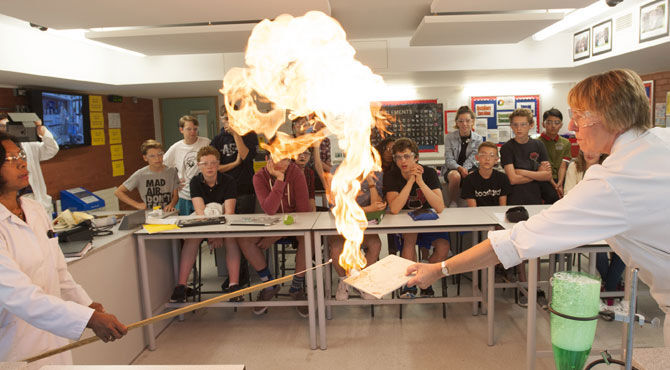STEM education: plugging the global skills shortage
Ensuring a strong labour market in a technology driven future, will require the STEM subjects to engage with students. Creating an environment of proactive thought at a young stage is key to success.

Engaging young students in STEM subjects
A consequence of this is a burgeoning global careers market for highly-skilled STEM graduates and school leavers.Today, international businesses demand ever more talent to help them compete in global marketplaces. These businesses also have higher than ever expectations of their young recruits too. This view is endorsed by ‘Inspiring Growth’, the CBI/Pearson Education Skills Survey, which cites that a degree in a science, technology, engineering and maths (STEM) subject can give graduates a clear advantage in the jobs market.So far so good, yet it seems that many young people are still reluctant to study STEM subjects at a higher level, a result of becoming disengaged with these crucial subjects earlier on at school, and a situation that has left global industries with a worrying STEM skills shortage.These four vital disciplines (science, technology, engineering and maths) are crucial in tackling the major challenges we face, from future-proofing transport infrastructure to feeding the world’s growing population.What can schools do to plug the shortage of key STEM skills?
The answer lies in the early encouragement of children to explore, engage and enjoy STEM subjects. That is, well before university and the study of higher education qualification courses. This means an approach to STEM in schools, which focuses on learning across all core subjects and applying teaching to real-world problems that students can identify with.Transferable learning
Traditional, didactic teaching methods, which explore individual subjects in isolation, are no longer appropriate or useful in today’s world. Subjects like science and maths cannot simply be taught in a stand-alone way if students are to develop the skills they will need to thrive at university and beyond.Young people must develop and apply transferable skills and be able to think across subject boundaries. Crucially, applying their thought beyond their classroom walls.Recognising this, STEM education should encourage students to understand how subject-specific skills can be applied in different ways across different subjects, and consider their wider implications.A biology student could, for example, incorporate basic maths to develop their knowledge of anatomy by measuring a heartbeat. This in turn expands understand of the engineering concepts that support the natural flow of blood through the heart, and take that forward to understand how a pacemaker works.Practical and interdisciplinary STEM learning like this helps students to become highly effective thinkers, doers, problem-solvers, collaborators and such stimulations also feed a desire for life-long learning.Related STEM articles:
- Education summit aims to inspire students to pursue STEM careers
- Closing the STEM skills gap
- British education: delivering STEM skills for the future
Students understand that their knowledge of a subject area is not finite or restricted to the classroom, and appreciate how it can be applied to real life problems.At ACS we run a space-themed LEGO robotics class, and for a final project, students build and programme robots. They then create science fiction stories for their robotic creations to “act" out. They are also able to film the robot scene and create an iBook.This type of open-ended task develops vital skills across science, technology and engineering, while inspiring students to be creative in the presentation of their projects. The result of task is an original piece of artwork that develops students’ vital STEM skills and encourages them to apply their knowledge, innovation and imagination.
Making STEM subjects accessible
STEM can also make core subjects more fun and approachable to younger students. A child who has never seen code or learnt about computer science will be far less intimidated and much more engaged if it relates to something they are already familiar with. Lower School ACS students, for example, were recently studying the respiratory system of the human body. As part of their assessment, they presented what they had learnt by creating a film to explain the different anatomy and systems. They used the app, Puppet Pals to do this, overlapping their knowledge across technology and science, while utilising their creativity to create multi-media projects that explain an anatomical process in a new way.This demonstrates how educators can begin to bring STEM education to life by challenging students to present a topic differently, or look at a lesson from another angle. Our Lower School students use apps like Hopscotch and Floors, as an arts-based way of learning to code. This cross-curriculum approach, combining art, technology and computer science, nurtures logical thinking, problem-solving and persistence, encourages collaboration and communication, while providing the opportunity for students to develop practical, future-focussed skills, in an imaginative, fun and creative way.Preparing students for the future
To provide the best opportunities and dynamic learning environment for STEM education, ACS Hillingdon has built a brand new Science Centre due to open this autumn.The Science Centre includes seven new laboratories featuring cutting-edge technology, which will help ensure that students are best prepared for university and ultimately successful careers, vital to the global workforce, for which STEM skills are required.Our pioneering approach to teaching and inspiring students to learn STEM subjects will help to cultivate a generation which is able to express new innovative ideas and perspectives across subjects and projects AND bring these ideas to life - ready to face the challenges of the modern world.For related news and features, visit our Education and Schools section.Access hundreds of global services and suppliers in our Online Directory Get access to our free Global Mobility Toolkit
Get access to our free Global Mobility Toolkit 
©2025 Re:locate magazine, published by Profile Locations, Spray Hill, Hastings Road, Lamberhurst, Kent TN3 8JB. All rights reserved. This publication (or any part thereof) may not be reproduced in any form without the prior written permission of Profile Locations. Profile Locations accepts no liability for the accuracy of the contents or any opinions expressed herein.




































